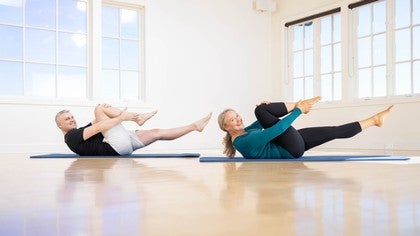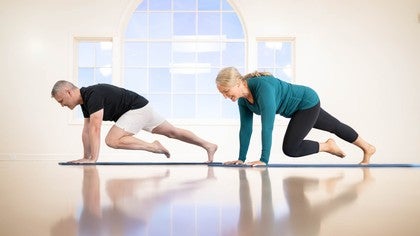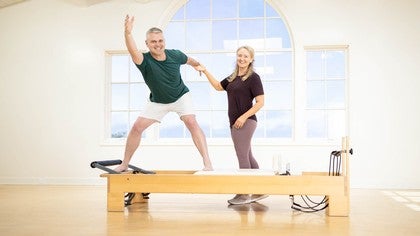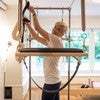Description
To find out more about this Hydration course, go to Reach Movement's website.
About This Video
Transcript
Read Full Transcript
Hello, I'm Sally Anderson, and welcome to Hydration. We are all living bodies of water. So we are by volume approximately 50 to 70 or arguably 75% of water. So that's a lot of water. By molecular count, 99%.
That's a lot of water molecules. So the issue of hydration or the topic of hydration is crucial for us in our modern world. We need to maintain hydration, and commonly we only really think about dehydration coming up when somebody is ill or you know, when you feel hydrated, which is often kind of finding the solution afterwards. It's closing the gate after the horse has left. So ideally we will maintain and manage this volume of water because it is so important to every function of our daily lives.
Water is a lubricant, a transporter. It participates in metabolic reactions in all our cells. Essentially everything we do relies on us having good hydration in our cells, in our tissues. Even our cognitive functions, or not just even our cognitive functions. That's so important for us to have hydration.
The brain requires so much water, and without it, we do feel fatigued, and our energy is zapped, and we don't function that well. So what I'm bringing you is a little look at how we can use the new and evolving science and research behind hydration in ways that are very sensible and practical. So thinking about how we take in hydration and then how we can best facilitate hydration around our body. So that's going to be our specialty, because we move, and movement is crucial. As I bring you some of my new work that I've been developing for Reach Movement Health, which is my new brand, looking at how we can use movement more prescriptively to achieve health outcomes, and the first thing I want to take you through is a little bit of understanding or an overview of hydration.
So with the Reach Hydration training course, we're providing a facilitation of the new and evolving science of hydration, and some of this is not yet mainstream. It is evolving and it's exciting, and it's really interesting, fascinating work. And what we're doing with Reach Hydration is bringing you the understanding of how important hydration is, and simple strategies that we can employ to improve our hydration, but most importantly, how we can use movement. So that's our specialty. And I want to give you just a few little pointers about why hydration is so fascinating to me, and the development of the work that we're producing, but then take you through some movements that will help you understand not only how crucial movement is to hydration and getting whole body tissue hydration, but also ways in which you can adapt the movements you're using in this wonderful Pilates work that we have in order to bring hydration more to the fore or to the focus of your work and help you and help your clients achieve optimal hydration.
So I personally became quite fascinated and like engaged in hydration as a topic because I felt myself getting more and more dehydrated, and as one particular doctor friend of mine said, it probably has a lot to do with my Celtic heritage, you know, my English, Scottish heritage, that that physiology tends to kind of dehydrate a little bit more, as a general idea. You know, it's not a given for everybody, but I think long days teaching, being in artificial environments, there's a lot of things that serve to dehydrate us, and we'll talk a little bit more about those in a moment, but those things were leading me to feel like I was getting more and more dehydrated. So it was a topic that resounded with me and I needed to find solutions for. Along the way, I came across Gina Bria, who is the founder of Hydration Foundation in New York, and Gina was doing the same sort of exploration as well. Gina was doing much more exploration than I was.
Gina is an anthropologist who was researching how desert dwellers remained hydrated in the absence of water, so it's a pretty good topic. What she found was that plant hydration was how they stayed far more hydrated, and you know, that was only one component of her research, but that to me really resonated. I was like, we know this. We know we need to take on hydration through food, through plant-based food, and in the absence of water, if a whole race and tribes can remain hydrated this way, that could be something that really works for us if we look at that with a greater focus. So this was kind of my lead into exploring more about the new science of hydration, and then finding people who are working very seriously about understanding the structure and the chemical composition of water.
And it's different in ourselves to actual water. So in the training course, we look at the differences between intra and intercellular water and H2O, but finding out a lot more about that work from people like Dr. Gerald Pollack and the Pollack Laboratory in University of Washington. They are constantly exploring the phases of water and structure of water. And even though this is still evolving, I think it's really worth us understanding where we're going and what we can take from their work that helps us all create better hydration and then create whole body tissue hydration. So getting back to what serves to dehydrate us these days.
There is so much, and personally I feel like I'm seeing hydration get less and less around me in clients, in my family, friends population. People are becoming more dehydrated year by year, and I think this has a lot to do with the variables that do dehydrate us, and some of those include air conditioning, that we're in a lot. Technology draws hydration from us. The schedules that we lead. We're busy, we're stressed.
That serves to dehydrate us. So some of the other daily things that dehydrate us will include medicines, speaking and talking a lot, which is how I really find that I end up feeling dehydrated, when I talk all day on a long teaching shift, and literally leading the lives we live, which we love and we want to keep doing, and that's the basis of what all our modern health training courses with Reach are about, is let's live these fantastic lives we've got, but let's find the ways to address the issues that come up and find solutions to it through movement. Then looking at what's dehydrating us, what strategies we can employ to be more hydrated, and these are very simple things. Yes, we can drink more water, but we know that we can also find our water from plants, and so looking at what plants, what fruits, what vegetables contain water that is closest to what we can absorb and we work through that in the training course in more detail, but there's some similarities from the water that we find in plants to what we need in ourselves. And so understanding that, very simply, we can change the way we intake hydration, but more importantly, what we do, we can move our hydration around the body, and that's where it gets really interesting for me, with what we do, with movement.
So we can start to look at what types of movement, and how we prescribe our movement to create more flow of movement through all the tissues of the body. And we know that connective tissue is really key in terms of how we can move fluids. That can be, you know, that connective tissue is like a messenger or the inner interweb in our body. So we're sending messages all the way around our body. We can send hydration all the way around our body as well, in and out of cells, sitting alongside our lymphatic system that flushes and drains.
It's a similar concept, that our musculoskeletal movement is going to pump or be the pumping system for hydration around our body, as much as it is lymphatic drainage, and a very good colleague of mine in Australia, Marissa Traino, does a training course on lymphatic drainage and how to move edema out of the body, and the parallels there are instantaneous and quite fascinating, and putting both those systems together is really quite simple. And what I'll take you through are some very simple movements that give you an example of how we can move hydration also while we're draining with lymph, but my focus is on moving hydration into all the tissues of the body that don't normally get it. So we want to try and access tissues that aren't readily getting hydration, and I'll show you some very simple exercises that should also let you think about how you can add these concepts to other exercises. So the few things I'll concentrate on just now in this tutorial are, one, micro-movements. Now, micro-movements are exactly what they sound like, small movements, and these micro-movements are proving to be really effective in terms of how you can help people move hydration around the body and do it in a way that everyone can access.
So this is gonna be particularly useful for people who are in situations where they don't have the ability to move in a larger way, and that might be, in a general sense, on airplanes. We can use micro-movements to keep a bit of hydration and movement of fluid through the tissues. People who are in hospital beds, wheelchairs, aged care facilities. We can give these people ways of moving that will help with hydration, that will help with flushing and flowing fluid through the tissues that doesn't require them being on a mat and doing a full workout. An example of a micro-movement can be simply a head nod.
So I like to start with just a slow motion first, and then build it into a faster motion, which gets smaller, and then you start to pump. Okay? So that's a micro-movement. We start with head nods, head pumps. So that's just like a yes movement.
This brings in the concept that I also want to introduce briefly, which is pumping. How that pumping focus in a movement is going to add the hydrating effect, and that will also then lead me into two more or basically a combined concept of twisting and pumping, so using a twisting motion. I will go into some exercises just to demonstrate, but we already have them in Pilates as well. So using twisting and pumping and micro-movements all serve to move hydration through our tissues. So here we go with that micro-movement again.
We're doing just the range of movement first to make sure that's easy and working, and then we take it into a pump, and we're moving fluid. Let's do that to the rotation. So looking over one shoulder, just find your range of movement first. Other shoulder. So you could do one or a few of these just to find the range and then get into your pump motion.
And then it can get smaller and little more pumping, but we're getting that movement, that contraction or pumping of the tissue. So then you can go into different ranges of movement using that idea of range of movement, and then pumping. I wanna show you another little exercise that I find beautiful for micro-movements moving into the shoulder girdle, and it's just a closed shoulder circle. So take the arms out, palms facing away, soften the elbows, and then you're just going to circle around the sternum. So that's just giving you a little kind of movement of the arms in all the joints.
So have a look at how the shoulders, elbows, and hands are all getting a little joint mobilization. And then the faster you get, you get that little pumping effect and you're sending all that movement to hydrate the tissues from the upper body that will then flow through the body. So I want to show you one last one, which I still incorporate in micro-movements, and it's our T rib movers, and I'll have one palm up, and I want you just to rotate the humerus in the shoulder joint, but let the ribs move with it. So I want those a ribs to really release and move, and I think of them just letting go, let them mobilize. Now the palm upside, you're going to start turning the head to look as you go.
So let the ribs move, and then we can get a little faster. Head turns. So we've got head and neck, shoulders, ribs, all getting movement, all getting hydration. Good. And then you can start to lift lower with the shoulders as you go through.
It might set the pace a little slower as you get used to it, and then once you've done six to 10 or however many feels good, take it back to just the head and arms, a little bit faster, and then take it back just to the arms unwinding and down. So that's our T rib movers. It really, you'll feel it at the end of that. It gets things flushing and flowing. So now I'd like to show you just a few more exercises that incorporate the twisting and pumping concept that I want you to employ.
So I'm going to ask my very dear colleague, Andrew Arastian, to come and give me a little demonstration here. Andrew's with us at Pilates any time to teach his own sessions, but he's gonna be good enough to teach for me. If I can have you quadruped position, please. So we'll just start with a thread the needle, one on the first side. Take your left arm up and just do a regular thread the needle for me, Andrew.
So the arm will come up, looking to that hand, and then the hand will thread through. Good. Come back to the center, and we'll pause. So that's our regular thread the needle. We're going to employ this hydration focus of pumping and twisting to give it more flow and flush and pump.
So we'll start with part one of this, which is pump the needle. So we're gonna take the elbow up and then walk through like a little spider or like, even though we'll do it over the edge of the bed here. And then you build that pace. So it's gonna go pump and through, pump, and that elbow drives the twist, and we get a nice rotation under. That's part one, and we'll come back to the center for part two.
Let's just keep the nice position. In part two, the hand goes up to the ceiling as usual, so we'll get a nice look to that hand, and then we are gonna do a little kind of pump under and back up. So we're gonna think of this like a rebound. It's a little bend under, and up. So if you were counting it, it would be and one, and one, and one, and back to center.
Good. All right, we're going to turn Andrew on his back, and these are exercises you know, and that's something I really do want everybody to understand with a lot of the work we do, is we wanna use the repertoire that we've got. We're just putting this focus into it to get a health outcome that we're after. So now we're looking at single leg stretch and crisscross, and the reason I wanna go through it here, and I'll have Andrew just come up and hug his knees to his chest. Chest lift up, ready for a single leg stretch.
We'll just do a regular single leg stretch, reach and two, and now what I want to do with this is make it a pump. So pump it, two, three, four, good. Still getting the reach of the leg, the pull in, and really, just if, Andrew, you'll pause. So one leg out, when you're getting that pull in, we're getting a lot of pump through the groin lymphatic area. So we're getting getting that lymphatic flushing as well as the pump of fluid through this really fast pacing movement.
Hands behind the head, and we'll just turn that into a crisscross. And one, two. So again, the range can get smaller, because you're after a particular outcome. It doesn't need to be as kind of controlled, and come back to the center and relax down. Good.
Feet down on the floor. One last exercise I'd like to take you through with these concepts, just so you've got a good kind of thought process going into other work that you will use with your clients to add that hydration focus. It's the hundred. So the hundred is built for hydrating and drainage through lymph systems. So let's just have a little look at it.
We'll only do thirties or forties here today. I'm gonna leave the legs down. You know all the variations of leg positions we can have, but just coming up into a chest lift. Let's just pump, one. So you're going to breathe in for five, breathe out for five, but it's this whole pump system that's going to push air and fluid around the body, and then my next progressions would be to go to tip toes with the legs, so we create a little bit more activity through the lower abdominals, legs go up and onward from there.
They can go puppy paw, tabletop, all the variations. Let's call that done. He's gonna go through all of them for me. So you've got these essential exercises in Pilates that really can create the hydration outcome that we're after, if we just think about how to really put those concepts into them. So at the end of this, I want you to take away with you a few concepts to put into your own work and that we will look at in our Hydration Mat Work class and a Hydration Reformer class that you'll find on this platform, but think about micro-movements being really effective for anybody, and to incorporate those into your programming.
But they can be given to people who wouldn't otherwise be able to move. I think that's really important in this day and age. They can be used by you as a teacher through your everyday training, just to have little breaks, daily doses, but think about twisting and pumping as primary concepts on how we can change up our repertoire to create more hydration and flush water in and out of our cells to get that lovely, hydrated tissue that looks spongy, soft, delicious, and wet as opposed to crispy, dry, compressed, and dehydrated, which we don't want. I hope you enjoyed that. I hope you'll join me for Hydration Mat Work and/or Hydration Reformer.
Thank you, Andrew. Thank you.
Reach Movement Health: Hydration
Comments
You need to be a subscriber to post a comment.
Please Log In or Create an Account to start your free trial.











